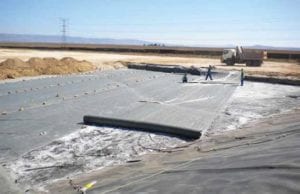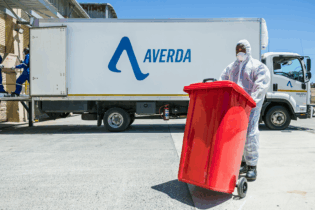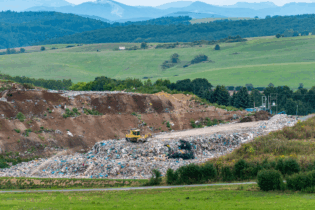Maryke Foulds speaks to Cheri Scholtz of PETCO and Chris Els of Kaytech about ten years of recycling cooperation.
Please give me some background on Kaytech and its involvement in the PET recycling industryKaytech (originally Noel Hunt Geofabrics), part of the Kaymac Group, is the pioneering entity that introduced Bidim geotextiles to the South African construction market with the first recorded installation in 1971. Kaytech continued to grow this market to a point where local production of this unique product became more attractive. The commissioning of Kaymac’s own Bidim production plant, situated in Atlantis, Cape Town, was completed at the end of 1978. Kaymac started with exploratory work introducing recycled polyester into its production process around 1984. Original sources of recycled polyester were from soft drink bottle production and reclaimed used soft drink bottles. Since 2001, all Bidim production has been from 100% recycled products, yielding a stronger product than that obtainable from virgin textilegrade PET polymer. What is the current status of PET recycling in South Africa?
It is estimated that South Africa produced 1.37 million tonnes of virgin plastic in 2013, with just over half being used in the packaging sector; 21% of this was recovered and 19.9% was recycled. Of the packaging market, the PET market size was 26%. Close on 70% of this was used in the beverage sector, with the remaining markets being the sheet/tray, personal care, food, household and edible oil sectors – PETCO achieved a recycling rate of 48% of post- consumer beverage PET in 2013 – that is, a collection of 59 691 tonnes. This growth in recycling figures, for the 9th consecutive year, would not have been possible without the continued voluntary financial support of PETCO’s shareholder members who enable the organisation to support the entire value chain and entrench PETCO as a successful model for voluntary EPR in South Africa. South Africa is on track and is working towards recycling 70% of post-consumer beverage PET by 2022. Currently, PET is recycled into three end-use products for the local and export markets:
• Bottle-2-Fibre/filament:
Polyester staple fibre/ filament, made from PET recyclate, is used in apparel, home textiles, automotive and industrial end-use applications.
• Bottle-2-Foodgrade:
rPET is blended with virgin material for the production of new PET containers for both food and non-food products.
• Bottle-2-Bottle:
Capacity is currently being installed for expansion into carbonated soft drink grade approved Bottle-2-Bottle resin. This is where the future growth in South Africa will be. Is this a growing market? If so, why?
The largest end-use market for post-consumer PET bottles in South Africa is currently the polyester staple fibre market, which is close to saturation. Bidim fits into the value chain in that its application and process is more tolerant to bottle types not currently considered desirable for the new bottle-to-bottle process, without compromising product integrity. Geotextile markets have shown a steady growth over the last 10 years, peaking around the time leading up to the 2010 FIFA World Cup. Currently mega projects like the Medupi and Kusile power stations and the infrastructure to support them (coal stockyards and discard areas and so on) are requiring significant lining systems in which geotextiles play a vital role. Mining is a significant contributor to geotextile usage; domestic and hazardous waste landfills, however, continue to generate the major demand for geosynthetic lining system designs incorporating geotextiles to ensure that the government-legislated minimum requirements are strictly adhered to. rPET is also blended with virgin material for the production of new PET containers for both food and non-food products. This is true closed-loop recycling. Capacity is currently being installed for expansion into carbonated soft drink grade approved Bottle-2-Bottle resin. Please elaborate on Kaytech’s recycling initiative and how the recycled product is reused to manufacture product
Bidim geotextile is produced from sorted, granulated and then washed polyester (PET) bottle flakes. The processed flake is supplied by both large formal, and smaller entrepreneurial, business, some of which were started some years back, specifically to supply the demand created by Bidim production. The Bidim production process consists of selective polymer blending, crystallisation, drying, pigmentation, extrusion, fibreand batt-forming and finally, consolidation via a needlepunching process into a fabric, finally presented much like a rolled carpet.
Please explain the use of PET recycled material in the geotextiles industry and how this is a greening initiative
PET food-grade polymer is manufactured to a high standard and behaves in a predictable way through its primary processing into bottles. This characteristic allows for the recycled polymer to be used in strictly controlled applications, like those for geotextiles.
Discarded post-consumer PET bottles are collected (principally by informal collectors), baled and delivered to the recycler. At present, PET fetches one of the highest prices at recycler, with approximately 33 bottles making up one kilogram of PET. Within the recycling plant, bottle tops are removed and the bottles are inspected and sorted according to colour and material. The sorted bottles are washed and then conveyed to a granulator, where they are chopped into flakes before being screened. These flakes are then washed, dried and conveyed to an extruder where the material is turned into pellets. The finished product takes the form of small, clear pellets which are supplied to end-users for the production of other items. The proprietary Bidim production process varies somewhat from staple fibre and bottle-to-bottle recycle processes. The Bidim process is unique in that it utilises recycled bottle material directly, not needing conversion into virgin mimicking pellets first. The ability to directly use the chopped-up bottle material makes the recycling process more energy efficient, reducing the overall carbon footprint of our product. Limiting the number of extrusion passes, compared to more traditional fibre recycling processes, aids in the retention of those desirable polymer properties. What is the relationship between Kaytech and PETCO and what is your vision for this partnership going forward?
Kaytech, as a contracted recycler, forms part of PETCO’s recycling drive by creating demand for post-consumer recycled PET. Bidim demand for recycled PET polymer offers an alternative to the land filling of this useful polymer. Bidim continues to offer an economically viable, long-term outlet for existing and future recycling initiatives. Amongst other things, PETCO supports projects that focus on increasing the economically viable collection and recycling of post-consumer PET. We provide financial assistance to large-scale projects that currently have an end-use product within their valuechains and subsidise recyclers for every ton of PET that they recycle. In order to sustain and grow PET bottle collection, consistent demand for postconsumer PET is required. PETCO could not achieve its collection targets without the support of our collectors and contracted service providers, like Kaytech. Our other contracted recyclers are Extrupet, who produce polyester staple fibre and bottle-to-food grade rPET; and Sen Li Da who produce polyester staple fibre. Later this year, a milestone will be achieved – one of PETCO’s contracted recyclers will be producing CSD grade (Bottle-2-Bottle) recycled resin for the industry. This would not have happened without the economic support of PETCO.








